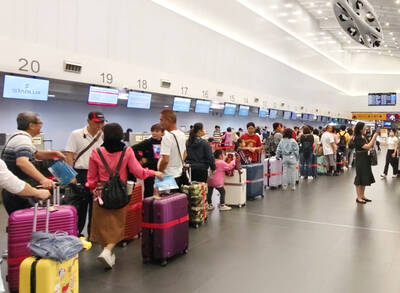Chinese Nationalist Party (KMT) Legislator Su Chi (
Su said he invented the term in order to break the cross-strait deadlock and alleviate tension.
"[Then president] Lee Teng-hui (
Su made the remarks yesterday in response to Lee who, during a Taiwan Solidarity Union seminar on Monday, said that the so-called "1992 consensus" was a fiction.
"Little monkey boy's trying to make up history," Lee said of Su, daring him to respond on the matter.
When asked by reporters for a response yesterday, Su said he did invent the term, which was meant to encourage observers to think that "each side has its own interpretation on the meaning of `one China.'"
The term "1992 consensus" is controversial. The KMT has insisted on the existence of a "consensus" between Taiwan and China during a meeting in Hong Kong in November 1992 that both sides should adhere to the "one China" principle.
Since the term appeared, however, the DPP government has insisted that no such consensus existed.
Stating that "no consensus" was reached on the definition of "one China" during the 1992 meeting, President Chen Shui-bian (
Su said he made up the term "1992 consensus" as a replacement for the expression "each side with its own interpretation" in order to benefit cross-strait development.
"The wording `each side with its own interpretation' of the `one China' principle" had been used from 1992 to 2000. But China didn't like the `each side with its own interpretation' part and the DPP government didn't like the part that said `one China,'" Su said.
"On account of these differences and the fact they could have led to more cross-strait tension after the DPP took power, I suggested the new term as a common point that was acceptable to both sides so that Taiwan and China could keep up cross-strait exchanges," he said.
Su said he initially thought the term could contribute to a resumption of cross-strait negotiations and did not think that it would be unacceptable to the DPP government.

Three Taiwanese airlines have prohibited passengers from packing Bluetooth earbuds and their charger cases in checked luggage. EVA Air and Uni Air said that Bluetooth earbuds and charger cases are categorized as portable electronic devices, which should be switched off if they are placed in checked luggage based on international aviation safety regulations. They must not be in standby or sleep mode. However, as charging would continue when earbuds are placed in the charger cases, which would contravene international aviation regulations, their cases must be carried as hand luggage, they said. Tigerair Taiwan said that earbud charger cases are equipped

Foreign travelers entering Taiwan on a short layover via Taiwan Taoyuan International Airport are receiving NT$600 gift vouchers from yesterday, the Tourism Administration said, adding that it hopes the incentive would boost tourism consumption at the airport. The program, which allows travelers holding non-Taiwan passports who enter the country during a layover of up to 24 hours to claim a voucher, aims to promote attractions at the airport, the agency said in a statement on Friday. To participate, travelers must sign up on the campaign Web site, the agency said. They can then present their passport and boarding pass for their connecting international

WEATHER Typhoon forming: CWA A tropical depression is expected to form into a typhoon as early as today, the Central Weather Administration (CWA) said yesterday, adding that the storm’s path remains uncertain. Before the weekend, it would move toward the Philippines, the agency said. Some time around Monday next week, it might reach a turning point, either veering north toward waters east of Taiwan or continuing westward across the Philippines, the CWA said. Meanwhile, the eye of Typhoon Kalmaegi was 1,310km south-southeast of Oluanpi (鵝鑾鼻), Taiwan’s southernmost point, as of 2am yesterday, it said. The storm is forecast to move through central

The age requirement for commercial pilots and airline transport pilots is to be lowered by two years, to 18 and 21 years respectively, to expand the pool of pilots in accordance with international standards, the Ministry of Transportation and Communications announced today. The changes are part of amendments to articles 93, 119 and 121 of the Regulations Governing Licenses and Ratings for Airmen (航空人員檢定給證管理規則). The amendments take into account age requirements for aviation personnel certification in the Convention on International Civil Aviation and EU’s aviation safety regulations, as well as the practical needs of managing aviation personnel licensing, the ministry said. The ministry